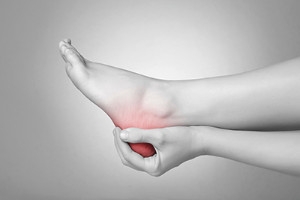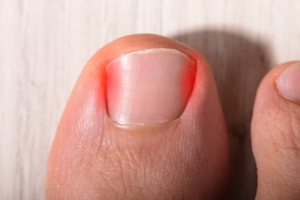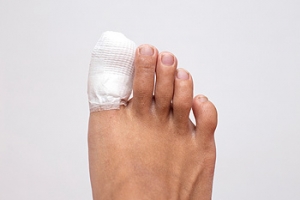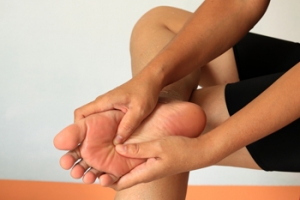Super User
Pregnancy and Foot Health
 Foot problems are a common complication associated with pregnancy, due to the extra weight and pressure that the feet endure. Three of the most common foot issues that occur during pregnancy are swollen feet, arch pain, and ingrown toenails. Throbbing and swollen feet can be a result of excess fluid buildup. Stretching, wearing wide comfortable shoes, and elevating your feet can help to reduce swelling. Additional weight on the feet during pregnancy can cause the arches to begin to flatten, which may then lead to arch pain. Stretches can also help to alleviate some of the pressure on the arch and help reduce pain. Since most women experience an increase in foot size during pregnancy, it is important to wear wider shoes. If the foot is cramped inside of a shoe that is too tight, this can easily lead to ingrown toenails, which are inconvenient and uncomfortable. If you would like additional information on how to care for your feet while pregnant, then it is recommended you speak with podiatrist.
Foot problems are a common complication associated with pregnancy, due to the extra weight and pressure that the feet endure. Three of the most common foot issues that occur during pregnancy are swollen feet, arch pain, and ingrown toenails. Throbbing and swollen feet can be a result of excess fluid buildup. Stretching, wearing wide comfortable shoes, and elevating your feet can help to reduce swelling. Additional weight on the feet during pregnancy can cause the arches to begin to flatten, which may then lead to arch pain. Stretches can also help to alleviate some of the pressure on the arch and help reduce pain. Since most women experience an increase in foot size during pregnancy, it is important to wear wider shoes. If the foot is cramped inside of a shoe that is too tight, this can easily lead to ingrown toenails, which are inconvenient and uncomfortable. If you would like additional information on how to care for your feet while pregnant, then it is recommended you speak with podiatrist.
Pregnant women with swollen feet can be treated with a variety of different methods that are readily available. For more information about other cures for swollen feet during pregnancy, consult with one of our podiatrists from Westside Podiatry Center, LLP. Our doctors will attend to all of your foot and ankle needs.
What Foot Problems Can Arise During Pregnancy?
One problem that can occur is overpronation, which occurs when the arch of the foot flattens and tends to roll inward. This can cause pain and discomfort in your heels while you’re walking or even just standing up, trying to support your baby.
Another problem is edema, or swelling in the extremities. This often affects the feet during pregnancy but tends to occur in the later stages.
How Can I Keep My Feet Healthy During Pregnancy?
- Wearing orthotics can provide extra support for the feet and help distribute weight evenly
- Minimize the amount of time spent walking barefoot
- Wear shoes with good arch support
- Wear shoes that allow for good circulation to the feet
- Elevate feet if you experience swelling
- Massage your feet
- Get regular, light exercise, such as walking, to promote blood circulation to the feet
If you have any questions please feel free to contact one of our offices located in Liverpool, Camillus, Skaneateles, Oswego, and Cicero, NY . We offer the newest diagnostic and treatment technologies for all your foot and ankle needs.
Foot Care for Pregnant Women
The natural weight that pregnant women gain causes their center of gravity to be completely altered. This causes them to have a new weight-bearing stance which adds pressure to the knees and feet. As a result, pregnant women often experience severe foot pain. The two most common foot issues experienced by women in their pregnancies are edema and over-pronation. It is important for all pregnant women to learn more about how to take care of their feet so they are more comfortable during their pregnancy.
Over-pronation, which is commonly referred to as flat feet, is caused when a person’s arch flattens out upon weight bearing. This causes the person’s feet to roll inward while walking. Pregnant women often experience this due to the sudden weight they gain.
Edema, also referred as swelling in the feet, typically occurs in the later part of the pregnancy. It is the result of the extra blood accumulated in the pregnant woman’s body. The enlarged uterus puts more pressure on the blood vessels in the pelvis which causes leg circulation to slow down. This causes blood to pool in the lower extremities.
Fortunately, there are ways to treat both edema and over-pronation. Edema can be treated by elevating the foot as often as possible. Wearing proper fitting footwear will also be helpful for those with edema. A treatment method for over-pronation could be orthotics. Orthotic inserts should be designed with appropriate arch support and medial rear foot for your foot.
It is best for pregnant women to buy new shoes during the day, because this is the time where swelling is at its peak. Pregnant women also shouldn’t rush when buying shoes. It is always advised that you make sure your shoes fit properly but this is especially important during pregnancy.
If you are a pregnant woman, you should consult with a podiatrist in order to make sure your feet are healthy throughout the entirety of your pregnancy.
Where Is the Plantar Fascia Located?
 Patients that have a medical condition known as plantar fasciitis may notice the pain that often accompanies this ailment is worse in the morning upon arising. It occurs as a result of an inflamed plantar fascia, which is the tissue on the sole of the foot that connects the heel to the toes. This can happen from an injury that has occurred, or from standing for extended periods of time throughout the day on a hard surface. Patients who have developed this condition may find moderate relief when the foot is elevated as frequently as possible. Additionally, it may feel better to wear shoes that have adequate cushioning in the heel area. If you feel you have plantar fasciitis, it is strongly suggested that you consult with a podiatrist who can offer proper treatment options.
Patients that have a medical condition known as plantar fasciitis may notice the pain that often accompanies this ailment is worse in the morning upon arising. It occurs as a result of an inflamed plantar fascia, which is the tissue on the sole of the foot that connects the heel to the toes. This can happen from an injury that has occurred, or from standing for extended periods of time throughout the day on a hard surface. Patients who have developed this condition may find moderate relief when the foot is elevated as frequently as possible. Additionally, it may feel better to wear shoes that have adequate cushioning in the heel area. If you feel you have plantar fasciitis, it is strongly suggested that you consult with a podiatrist who can offer proper treatment options.
Plantar fasciitis can be very painful and inconvenient. If you are experiencing heel pain or symptoms of plantar fasciitis, contact one of our podiatrists from Westside Podiatry Center, LLP. Our doctors can provide the care you need to keep you pain-free and on your feet.
What Is Plantar Fasciitis?
Plantar fasciitis is the inflammation of the thick band of tissue that runs along the bottom of your foot, known as the plantar fascia, and causes mild to severe heel pain.
What Causes Plantar Fasciitis?
- Excessive running
- Non-supportive shoes
- Overpronation
- Repeated stretching and tearing of the plantar fascia
How Can It Be Treated?
- Conservative measures – anti-inflammatories, ice packs, stretching exercises, physical therapy, orthotic devices
- Shockwave therapy – sound waves are sent to the affected area to facilitate healing and are usually used for chronic cases of plantar fasciitis
- Surgery – usually only used as a last resort when all else fails. The plantar fascia can be surgically detached from the heel
While very treatable, plantar fasciitis is definitely not something that should be ignored. Especially in severe cases, speaking to your doctor right away is highly recommended to avoid complications and severe heel pain. Your podiatrist can work with you to provide the appropriate treatment options tailored to your condition.
If you have any questions please feel free to contact one of our offices located in Liverpool, Camillus, Skaneateles, Oswego, and Cicero, NY . We offer the newest diagnostic and treatment technologies for all your foot and ankle needs.
Plantar Fasciitis
Plantar fasciitis is one of the most common causes of heel pain. The plantar fascia is the thick band of tissue that connects the heel bone to the toes. When this band of connective tissue becomes inflamed, plantar fasciitis occurs. Fortunately, this condition is treatable.
There are several factors that may put you at a greater risk for developing plantar fasciitis. One of the biggest factors is age; plantar fasciitis is common in those between the ages of 40 to 60. People who have jobs that require them to be on their feet are also likely to develop plantar fasciitis. This includes factory workers, teachers, and others who spend a large portion of their day walking around on hard surfaces. Another risk factor is obesity because excess weight can result in extra stress being placed on the plantar fascia.
People with plantar fasciitis often experience a stabbing pain in the heel area. This pain is usually at its worst in the morning, but can also be triggered by periods of standing or sitting. Plantar fasciitis may make it hard to run and walk. It may also make the foot feel stiff and sensitive, which consequently makes walking barefoot difficult.
Treatment for plantar fasciitis depends on the severity of the specific case of the condition. Ice massage applications may be used to reduce pain and inflammation. Physical therapy is often used to treat plantar fasciitis, and this may include stretching exercises. Another treatment option is anti-inflammatory medication, such as ibuprofen.
If you suspect that you have plantar fasciitis, meet with your podiatrist immediately. If left untreated, symptoms may lead to tearing and overstretching of the plantar fascia. The solution is early detection and treatment. Be sure to speak with your podiatrist if you are experiencing heel pain.
Ballet Dancers And Ingrown Toenails
 One of the injuries that many ballet dancers endure are ingrown toenails. It can occur as a result of balancing on the tips of the toes for the majority of the dance, and can cause severe pain and discomfort. The noticeable symptoms of this ailment often include the sides of the nail growing into the surrounding skin, and it may often be red and inflamed. Common causes for ballet dancers to develop ingrown toenails can include dancing for hours at a time during rehearsals and performances. Additionally, if the nails are trimmed incorrectly, this may cause the condition to develop. There are methods that can be implemented which may prevent ingrown toenails from forming. These can include trimming the nails straight across the toe, and keeping the toes and feet clean. If you have an ingrown toenail, it is suggested to speak with a podiatrist who can treat this condition and can help you to avoid an infection from developing.
One of the injuries that many ballet dancers endure are ingrown toenails. It can occur as a result of balancing on the tips of the toes for the majority of the dance, and can cause severe pain and discomfort. The noticeable symptoms of this ailment often include the sides of the nail growing into the surrounding skin, and it may often be red and inflamed. Common causes for ballet dancers to develop ingrown toenails can include dancing for hours at a time during rehearsals and performances. Additionally, if the nails are trimmed incorrectly, this may cause the condition to develop. There are methods that can be implemented which may prevent ingrown toenails from forming. These can include trimming the nails straight across the toe, and keeping the toes and feet clean. If you have an ingrown toenail, it is suggested to speak with a podiatrist who can treat this condition and can help you to avoid an infection from developing.
Ingrown toenails can become painful if they are not treated properly. For more information about ingrown toenails, contact one of our podiatrists of Westside Podiatry Center, LLP. Our doctors can provide the care you need to keep you pain-free and on your feet.
Ingrown Toenails
Ingrown toenails occur when a toenail grows sideways into the bed of the nail, causing pain, swelling, and possibly infection.
Causes
- Bacterial infections
- Improper nail cutting such as cutting it too short or not straight across
- Trauma to the toe, such as stubbing, which causes the nail to grow back irregularly
- Ill-fitting shoes that bunch the toes too close together
- Genetic predisposition
Prevention
Because ingrown toenails are not something found outside of shoe-wearing cultures, going barefoot as often as possible will decrease the likeliness of developing ingrown toenails. Wearing proper fitting shoes and using proper cutting techniques will also help decrease your risk of developing ingrown toenails.
Treatment
Ingrown toenails are a very treatable foot condition. In minor cases, soaking the affected area in salt or antibacterial soaps will not only help with the ingrown nail itself, but also help prevent any infections from occurring. In more severe cases, surgery is an option. In either case, speaking to your podiatrist about this condition will help you get a better understanding of specific treatment options that are right for you.
If you have any questions please feel free to contact one of our offices located in Liverpool, Camillus, Skaneateles, Oswego, and Cicero, NY . We offer the newest diagnostic and treatment technologies for all your foot and ankle needs.
Ingrown Toenails
An ingrown toenail is a nail that has curved downward and grown into the skin. This typically occurs at either the nail borders or the sides of the nail. As a result, pain, redness, swelling, and warmth may occur in the toe. If a break in the skin forms due to the ingrown nail, bacteria may enter and cause an infection in the area; this is typically characterized by a foul odor and drainage.
Ingrown toenails have multiple reasons for developing. In many instances, the condition is a result of genetics and is inherited. The most common cause, however, is improper trimming; cutting the toenails too short forces the skin beside the nail to fold over. An ingrown toenail can also develop due to trauma, such as stubbing the toe, having an object fall on the toe, or participating in activities that involve repeated kicking or running. Wearing shoes that are too tight or too short can also cause ingrown toenails.
Treatment for an ingrown toenail varies between patients and the severity of the condition. In most cases, it is best to see your podiatrist for thorough and proper treatment. After examining your toe, your podiatrist may prescribe oral antibiotics to clear the infection if one is present. Surgical removal of either a portion of the nail or the entire nail may also be considered. In some cases, complete removal or destruction of the nail root may be required. Most patients who undergo nail surgery experience minimal pain afterward and can return to normal activity the following day.
Ingrown toenails can be prevented with proper nail trimming and by avoiding improper-fitting shoes. When cutting the toenails, be sure that you are cutting in a straight line and avoid cutting them too short. Shoes should not be too short or tight in the toe box.
How Can I Support My Broken Toe as It Heals?
 It is fairly common for a person to have broken their pinky toe. This can happen as a result of a heavy object falling on top of it, or possibly from stubbing it against a piece of furniture. When the pinky toe is broken, you may still be able to walk on it, however it can produce severe pain and discomfort. An effective treatment for a broken pinky toe may be referred to as buddy taping. This is done by taping the affected toe to the toe next to it. This procedure may help to support the broken toe as the healing process takes place. Severe fractures may produce a fever, and it may be necessary to perform surgery or to take pain medication. If you have broken your toe, please consult with a podiatrist who can properly treat a broken toe.
It is fairly common for a person to have broken their pinky toe. This can happen as a result of a heavy object falling on top of it, or possibly from stubbing it against a piece of furniture. When the pinky toe is broken, you may still be able to walk on it, however it can produce severe pain and discomfort. An effective treatment for a broken pinky toe may be referred to as buddy taping. This is done by taping the affected toe to the toe next to it. This procedure may help to support the broken toe as the healing process takes place. Severe fractures may produce a fever, and it may be necessary to perform surgery or to take pain medication. If you have broken your toe, please consult with a podiatrist who can properly treat a broken toe.
A broken toe can be very painful and lead to complications if not properly fixed. If you have any concerns about your feet, contact one of our podiatrists from Westside Podiatry Center, LLP. Our doctors will treat your foot and ankle needs.
What to Know About a Broken Toe
Although most people try to avoid foot trauma such as banging, stubbing, or dropping heavy objects on their feet, the unfortunate fact is that it is a common occurrence. Given the fact that toes are positioned in front of the feet, they typically sustain the brunt of such trauma. When trauma occurs to a toe, the result can be a painful break (fracture).
Symptoms of a Broken Toe
- Throbbing pain
- Swelling
- Bruising on the skin and toenail
- The inability to move the toe
- Toe appears crooked or disfigured
- Tingling or numbness in the toe
Generally, it is best to stay off of the injured toe with the affected foot elevated.
Severe toe fractures may be treated with a splint, cast, and in some cases, minor surgery. Due to its position and the pressure it endures with daily activity, future complications can occur if the big toe is not properly treated.
If you have any questions please feel free to contact one of our offices located in Liverpool, Camillus, Skaneateles, Oswego, and Cicero, NY . We offer the newest diagnostic and treatment technologies for all your foot and ankle needs.
What to Know About a Broken Toe
Trauma to the foot, especially the toes, can occur in many ways. Banging them, stubbing them, or dropping something on them are a few different ways this trauma can occur. Given the fact that toes are positioned in front of the feet, they typically sustain the brunt of such trauma. When trauma occurs to a toe, the result can be a painful break or fracture. Another type of trauma that can break a toe is repeated activity that places stress on the toe for prolonged periods of time.
Broken toes can be categorized as either minor or severe fractures. Symptoms of minor toe fractures include throbbing pain, swelling, bruising on the skin and toenail, and the inability to move the toe with ease. Severe toe fractures require medical attention and are indicated when the broken toe appears crooked or disfigured, when there is tingling or numbness in the toe, or when there is an open, bleeding wound present on the toe.
Generally, a minor toe break will heal without long-term complications. However, it is important to discontinue activities that put pressure on the toe. It is best to stay off of the injured toe and immediately get a splint or cast to prevent any more additional movement of the toe bones. You can also immobilize your toe by placing a small cotton ball between the injured toe and the toe beside it. Then, tape the two toes together with medical tape. Swelling can be alleviated by placing an ice pack on the broken toe directly as well as elevating your feet above your head.
Severe toe fractures may be treated with a splint, cast, and in some cases, minor surgery, especially when the big toe has been broken. Due to its position and the pressure the big toe endures with daily activity, future complications can occur if it is not properly treated. Pain associated with minor toe fractures can be managed with over-the-counter pain medications. Prescription pain killers may be necessary for severe toe fractures.
The healing time for a broken toe is approximately four to six weeks. In severe cases where the toe becomes infected or requires surgery, healing time can take up to eight weeks or more. While complications associated with a broken toe are immediately apparent, it is important to note that there are rare cases when additional complications, such as osteoarthritis, can develop over time. You should immediately speak with your podiatrist if you think you have broken your toe due to trauma. They will be able to diagnose the injury and recommend the appropriate treatment options.
Possible Causes of Morton’s Neuroma
 The medical condition that is known as Morton’s neuroma is defined as swelling around the nerves that pass between the bones in the foot. It can cause pain and discomfort at the ball of the foot, as well as a burning or numbing sensation in the toes. It can develop as a result of a muscular disorder, in addition to participating in certain sporting activities. Wearing high heels may cause this condition to develop, and this can be due to minimal room for the toes to move freely in. Effective treatments may consist of wearing custom made orthotics, and performing specific exercises and stretches that may help in the healing process. If you have any of these symptoms, it is advised that you are under the care of a podiatrist who can offer correct treatment techniques.
The medical condition that is known as Morton’s neuroma is defined as swelling around the nerves that pass between the bones in the foot. It can cause pain and discomfort at the ball of the foot, as well as a burning or numbing sensation in the toes. It can develop as a result of a muscular disorder, in addition to participating in certain sporting activities. Wearing high heels may cause this condition to develop, and this can be due to minimal room for the toes to move freely in. Effective treatments may consist of wearing custom made orthotics, and performing specific exercises and stretches that may help in the healing process. If you have any of these symptoms, it is advised that you are under the care of a podiatrist who can offer correct treatment techniques.
Morton’s neuroma is a very uncomfortable condition to live with. If you think you have Morton’s neuroma, contact one of our podiatrists of Westside Podiatry Center, LLP. Our doctors will attend to all of your foot care needs and answer any of your related questions.
Morton’s Neuroma
Morton's neuroma is a painful foot condition that commonly affects the areas between the second and third or third and fourth toe, although other areas of the foot are also susceptible. Morton’s neuroma is caused by an inflamed nerve in the foot that is being squeezed and aggravated by surrounding bones.
What Increases the Chances of Having Morton’s Neuroma?
- Ill-fitting high heels or shoes that add pressure to the toe or foot
- Jogging, running or any sport that involves constant impact to the foot
- Flat feet, bunions, and any other foot deformities
Morton’s neuroma is a very treatable condition. Orthotics and shoe inserts can often be used to alleviate the pain on the forefront of the feet. In more severe cases, corticosteroids can also be prescribed. In order to figure out the best treatment for your neuroma, it’s recommended to seek the care of a podiatrist who can diagnose your condition and provide different treatment options.
If you have any questions, please feel free to contact one of our offices located in Liverpool, Camillus, Skaneateles, Oswego, and Cicero, NY . We offer the newest diagnostic and treatment technologies for all your foot care needs.
Morton's Neuroma
Morton's Neuroma, also called Intermetatarsal Neuroma or Plantar Neuroma, is a condition that affects the nerves of the feet, usually the area between the third and fourth toe. Neuroma refers to a benign growth that can occur in different parts of the body. Morton's Neuroma strictly affects the feet. This condition causes the tissue around the nerves that lead to the toes becoming thick, causing pain in the ball of the foot.
This condition can be caused by injury, pressure or irritation. Normally no lump will be felt, but instead burning pain in the ball of the foot will be experienced. Numbness and tingling may also occur. With the onset of this condition, a person may feel pain when tight or narrow shoes are worn. As the condition worsens, the pain may persist for days, or even weeks.
Persistent foot pain should always be a concern. The foot should be examined by a podiatrist if pain persists longer than a few days with no relief from changing shoes. The earlier the foot is examined and treated, the less chance there will be for surgical treatment.
There are some factors that can play a role in the development of Morton's Neuroma. These include wearing ill-fitting shoes that cause pressure to the toes, such as high heels. Also, high impact exercise may contribute to the cause of this condition. Morton’s Neuroma may also develop if the foot sustains an injury. Another cause includes walking abnormally due to bunions or flat feet. This causes excessive pressure and irritates the tissue. At times, people are affected for no determinable reason.
Podiatrists can alleviate the effects of this condition using a treatment plan to help decrease the pain and heal the foot tissue. Depending upon the severity of the Morton's Neuroma, the treatment plan can vary. For cases that are mild to moderate, treatments may include applying padding to the arch to relieve pressure from the nerve and reduce compression while walking. Ice packs can also help reduce swelling. The podiatrist may also create a custom orthotic device to support the foot and reduce compression and pressure on the affected nerve. The doctor will probably advise against partaking in activities that cause constant pressure on the affected area. They may provide wider shoes to ease the pressure from the toes. If these treatments do not relieve the symptoms of this condition, the doctor may use injection therapy.
Surgical treatment may be recommended by the podiatrist if all other treatments fail to provide relief. Normally, the podiatric surgeon will decide on either a surgical procedure that involves removal of the affected nerve or will choose surgery to release the nerve. After examination, the surgeon will decide on the best approach to treat the problem.
Recovery varies according to the type of surgical procedure. The patient will also be instructed on the best shoe wear to prevent the return of this condition, along with changes to workout routines, if this was a cause. Preventative measures are important in ensuring the condition does not return.





